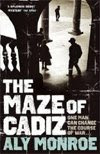Today may be Hot Cross Bun day, but on Viernes Santo (Good Friday) in Spain, it’s traditional to eat Arroz con Leche (Rice with Milk). I have never liked rice pudding – really, not at all - but I was introduced to this when I lived in Cadiz and it is a totally different creature. There are many different versions, with different ratios of milk to rice and sugar, some with added egg yolks and some without. All have cinnamon as a star ingredient and can be eaten hot or cold.
The dish is supposed to be of Moorish origin (as are many Spanish recipes) - some versions include raisins and/or rose water, decorated with rose petals (no added egg yolks for this version) - but the version I like best was given to me by a friend from Malaga. It’s made with lemon and cinnamon, and for me is much nicer cold. It’s great for kids (makes a change from yoghourt), but it can also be used as a cool summer dessert, happily made in advance, when you have friends over. It looks good, too.
The following ingredients are approximate, depending on how liquid you like it and how sweet you like it. Slightly less rice to milk will be needed if you thicken with egg yolks:
Arroz con Leche
Ingredients
4 cups of full cream milk
¾ - 1 cup of round grain rice
Approx ¾ cup of white sugar (this depends on your taste – some recipes say as much as 1 ¼ cups)
The peeled rind of a small lemon (some recipes also include some orange peel)
A cinnamon stick.
To decorate: brown sugar mixed with powdered cinnamon (or rose petals, in the raisin and rose water version without egg yolks).
Method
Wash the rice and place in a saucepan together with the milk, the sugar, the lemon (and/or orange) rind and the cinnamon stick.
Cook gently over a low heat, stirring occasionally at first, increasing to constantly as the rice gradually cooks and absorbs the milk.
When it is practically cooked and becoming creamy, remove from the heat and leave to stand.
If preparing the raisin and rose water version, add these now, and remove the citrus peel and cinnamon stick. Pour into a dish/individual ramekins and decorate with rose petals
If preparing the lemon and egg yolk version, place three egg yolks in a cup. Stir well and mix in a little of the rice mixture, then add this to the pan and stir. Return to the heat (very low) and stir continuously until it becomes silky and thickened. Remove the pan from the heat and leave for approximately ten minutes. Take out the lemon rind and cinnamon stick and pour into a dish/ individual ramekins. Decorate with a mixture of brown sugar and cinnamon, sprinkled in a lattice across the surface.
Leave to chill – and eat.






